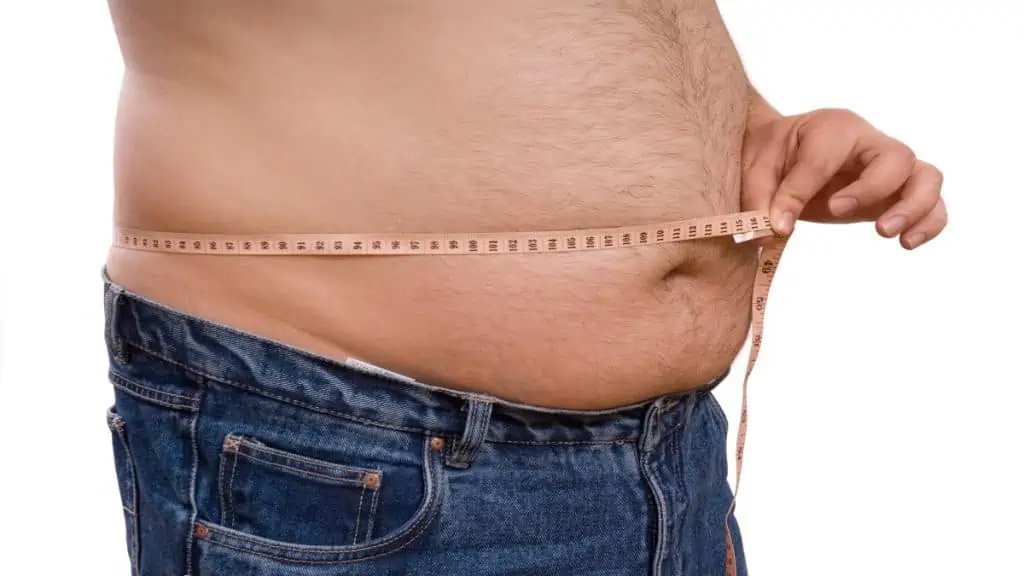
A 41 inch waist is a measurement used to determine the size of a person’s midsection. It indicates that the circumference around the widest part of the abdomen is 41 inches. This measurement is commonly used in healthcare settings to assess a person’s overall health, as excess fat around the waistline can increase the risk of various health problems.
A waist size of 41 inches can indicate that a person is carrying excess weight, especially around the midsection. This excess weight can be a result of a sedentary lifestyle, unhealthy eating habits, or genetic factors. It can also be a symptom of underlying health conditions such as insulin resistance, hormonal imbalances, or metabolic disorders.
Maintaining a healthy waist size is important for overall health and well-being. If your tummy is too big, it can cause problems for your health. A tummy that is over 40 inches for men or 35 inches for women can cause heart problems, stroke, and type 2 diabetes. To stay healthy, you can exercise, eat good food, and keep your weight in a healthy range. This will help prevent health problems.

In summary, having a waist that is too big, like 41 inches, can be unhealthy and might cause some problems for your body. To stay healthy and avoid these problems, it’s important to live a healthy lifestyle and keep your waist size in check.
- 40″ waist
- 42″ waist
- 43″ waist
- 44″ waist
- 45″ waist
- 46″ waist
- 47″ waist
- 48″ waist
- 49″ waist
Contents
Is a 41 inch waist big for a woman?
Yes, a 41 inch waist is considered big for a woman. Having a waist size of 35 inches or more for women indicates obesity, which can lead to serious health problems such as heart disease, high blood pressure, and diabetes. It’s important to maintain a healthy weight by exercising regularly and eating a balanced diet.
Additionally, measuring waist circumference is one way to determine if someone is at risk for certain health conditions. It’s important to pay attention to the size of your waist compared to your hips. Having too much fat around your waist can be really bad for your health. This is called central obesity.

If you’re worried about your waist size or health, talk to a doctor who can give you advice and help you. You can also make little changes like moving more and eating healthier food that can make a big difference for your health later on.
How about for a man?
A 41 inch waist is considered big for a man. Having a waist size of 40 inches or more for men indicates obesity, which can lead to serious health problems such as heart disease, high blood pressure, and diabetes. It’s important to maintain a healthy weight by exercising regularly and eating a balanced diet.
Measuring waist circumference is one way to determine if someone is at risk for certain health conditions. Waist-to-hip ratio is also an important factor to consider, as excess fat around the waist area (known as central obesity) is particularly dangerous to health.
If you’re concerned about your waist size or overall health, it’s a good idea to make some lifestyle changes such as increasing physical activity and making healthier food choices. Even small changes can have a big impact on your health in the long term.

Remember, obesity is a serious condition that requires attention and action to prevent and manage. Seek advice from a healthcare professional who can provide personalized advice and support for your specific needs.
What affects the appearance of a 41 in waist?
The appearance of a 41-inch waist can be influenced by various factors.
- Firstly, a sedentary lifestyle with little to no exercise can cause an accumulation of fat in the waist area, leading to a larger waistline.
- Secondly, consuming a diet high in calories, saturated fats, and sugars can contribute to weight gain and increase waist circumference.
- Additionally, genetics and body shape can also play a role in determining waist size. Some people may have a more prominent midsection due to their body structure and shape.
- Moreover, hormonal imbalances such as high cortisol levels, insulin resistance, and thyroid disorders can lead to weight gain and a larger waistline.
- Lastly, certain medications such as corticosteroids and antidepressants can cause weight gain and affect waist size.

To sum up, various factors such as lifestyle choices, genetics, hormonal imbalances, and medication use can all impact the appearance of a 41-inch waist. Adopting healthy habits like regular exercise and a balanced diet can help reduce waist size and promote overall health.
How can I slim my stomach?
If you want to slim your stomach, there are some things you can try:
- Firstly, focus on eating a healthy diet that includes plenty of fruits, vegetables, lean proteins, and whole grains. Limiting processed and high-fat foods can help reduce calories and promote weight loss.
- Secondly, engaging in regular exercise can help tone your abdominal muscles and burn excess fat. Cardiovascular activities like walking, jogging, or cycling can burn calories and promote weight loss.
- Thirdly, specific exercises like crunches, planks, and leg raise can target your abdominal muscles and help them become stronger and more defined.
- Moreover, managing stress can help reduce cortisol levels, a hormone that contributes to belly fat. Practicing relaxation techniques like yoga or meditation can help reduce stress levels.
Lastly, getting enough sleep is important for weight management and can reduce the risk of weight gain. Aim for 7-9 hours of sleep per night to support overall health.

To sum up, adopting a healthy lifestyle that includes a balanced diet, regular exercise, stress management, and adequate sleep can help you slim your stomach and improve your overall health.
Is having a 41 inch waistline good or bad?
A waistline of 41 inches is generally considered to be on the higher side, which may not be ideal for overall health. A larger waist circumference is often associated with an increased risk of several health issues, including diabetes, heart disease, and high blood pressure.
A waist circumference of 40 inches or more for men and 35 inches or more for women is typically considered to be abdominal obesity. Abdominal obesity can lead to the accumulation of visceral fat, which surrounds the organs and can lead to health problems.
It’s important to note that waist circumference alone cannot determine a person’s health status. Other factors, such as age, gender, and body composition, should also be taken into consideration.
If you have a waist circumference of 41 inches or more, it may be beneficial to adopt healthy lifestyle habits, such as regular exercise, a balanced diet, and stress management techniques. These habits can help you maintain a healthy weight and reduce the risk of developing health problems associated with abdominal obesity.

In summary, a waistline of 41 inches may not be ideal for overall health, and adopting healthy lifestyle habits can be beneficial for reducing the risk of health issues.
Conclusion
In conclusion, a waist size of 41 inches is considered big for both men and women and can indicate excess weight and be a risk factor for various health problems. Maintaining a healthy waist size is crucial for overall health and wellbeing, and small lifestyle changes such as regular physical activity and a healthy diet can have a big impact in the long term. The appearance of a 41-inch waist can be influenced by various factors such as genetics, hormonal imbalances, and medication use. However, adopting healthy habits like regular exercise, stress management, and a balanced diet can help reduce waist size and promote overall health. It is important to seek advice from a healthcare professional if concerned about waist size or overall health. Remember, a healthy lifestyle is crucial for preventing and managing obesity and related health issues.
References
- Centers for Disease Control and Prevention. (2021). About Adult BMI. Retrieved from https://www.cdc.gov/healthyweight/assessing/bmi/adult_bmi/index.html
- Harvard Health Publishing. (2019). Abdominal obesity and your health. Retrieved from https://www.health.harvard.edu/staying-healthy/abdominal-obesity-and-your-health
- Mayo Clinic. (2021). Belly fat in men: Why weight loss matters. Retrieved from https://www.mayoclinic.org/healthy-lifestyle/mens-health/in-depth/belly-fat/art-20045685
- National Heart, Lung, and Blood Institute. (2021). Assessing your weight and health risk. Retrieved from https://www.nhlbi.nih.gov/health/educational/lose_wt/risk.htm